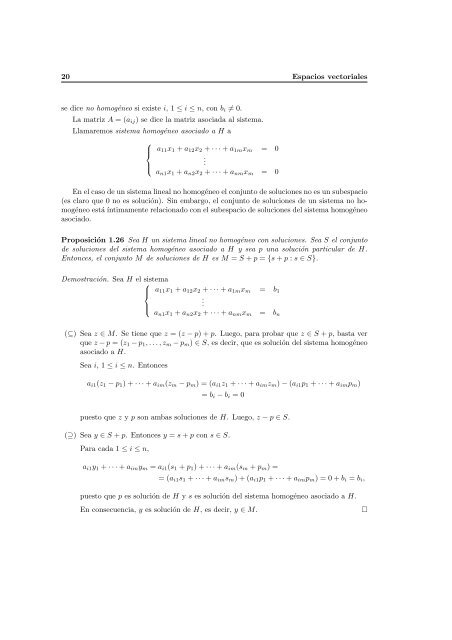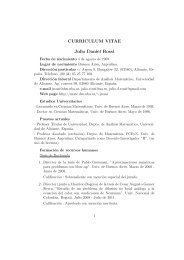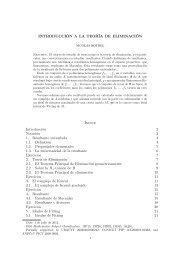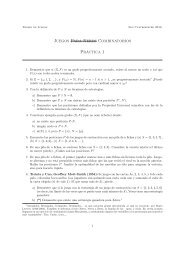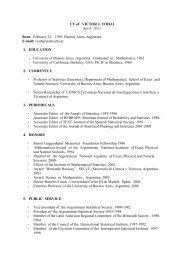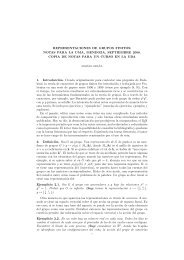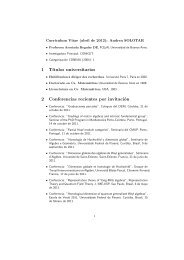- Page 1: Gabriela Jeronimo, Juan Sabia y Sus
- Page 5 and 6: Índice General 1 Espacios vectoria
- Page 7 and 8: ÍNDICE GENERAL vii 5.3.3 Regla de
- Page 9 and 10: ÍNDICE GENERAL ix 10.4.1 Clasifica
- Page 11 and 12: Capítulo 1 Espacios vectoriales En
- Page 13 and 14: 1.1 Espacios vectoriales y subespac
- Page 15 and 16: 1.1 Espacios vectoriales y subespac
- Page 17 and 18: 1.1 Espacios vectoriales y subespac
- Page 19 and 20: 1.1 Espacios vectoriales y subespac
- Page 21 and 22: 1.1 Espacios vectoriales y subespac
- Page 23 and 24: 1.2 Sistemas de ecuaciones lineales
- Page 25 and 26: 1.2 Sistemas de ecuaciones lineales
- Page 27 and 28: 1.2 Sistemas de ecuaciones lineales
- Page 29: 1.2 Sistemas de ecuaciones lineales
- Page 33 and 34: 1.3 Independencia lineal y bases 23
- Page 35 and 36: 1.3 Independencia lineal y bases 25
- Page 37 and 38: 1.3 Independencia lineal y bases 27
- Page 39 and 40: 1.3 Independencia lineal y bases 29
- Page 41 and 42: 1.4 Suma de subespacios 31 Observar
- Page 43 and 44: 1.4 Suma de subespacios 33 Esta tri
- Page 45 and 46: 1.4 Suma de subespacios 35 Demostra
- Page 47 and 48: 1.5 Ejercicios 37 ii) Probar que R
- Page 49 and 50: 1.5 Ejercicios 39 Ejercicio 13. Res
- Page 51 and 52: 1.5 Ejercicios 41 iii) S3 = {A ∈
- Page 53 and 54: 1.5 Ejercicios 43 i) S = < (1, 1, 2
- Page 55 and 56: 1.5 Ejercicios 45 Ejercicio 45. Dec
- Page 57 and 58: Capítulo 2 Matrices En el capítul
- Page 59 and 60: 2.1 Definiciones y propiedades 49 P
- Page 61 and 62: 2.2 Matrices inversibles 51 En esta
- Page 63 and 64: 2.3 Matrices elementales 53 Esto co
- Page 65 and 66: 2.4 Coordenadas 55 En particular, e
- Page 67 and 68: 2.4 Coordenadas 57 Sea x ∈ V . Si
- Page 69 and 70: 2.5 Ejercicios 59 2.5 Ejercicios Ej
- Page 71 and 72: 2.5 Ejercicios 61 iii) Si K = R, pr
- Page 73 and 74: 2.5 Ejercicios 63 Ejercicio 20. Cal
- Page 75 and 76: Capítulo 3 Transformaciones lineal
- Page 77 and 78: 3.1 Definiciones, ejemplos y propie
- Page 79 and 80: 3.1 Definiciones, ejemplos y propie
- Page 81 and 82:
3.1 Definiciones, ejemplos y propie
- Page 83 and 84:
3.3 Teorema de la dimensión 73 Vea
- Page 85 and 86:
3.4 Proyectores 75 (2. ⇒ 3.) Por
- Page 87 and 88:
3.5 Representación matricial 77 En
- Page 89 and 90:
3.6 Rango de una matriz 79 Demostra
- Page 91 and 92:
3.6 Rango de una matriz 81 Demostra
- Page 93 and 94:
3.7 Espacios vectoriales de transfo
- Page 95 and 96:
3.8 Ejercicios 85 • T es un isomo
- Page 97 and 98:
3.8 Ejercicios 87 v) Hallar una fó
- Page 99 and 100:
3.8 Ejercicios 89 ii) Hallar ecuaci
- Page 101 and 102:
3.8 Ejercicios 91 ii) Sea V un K-es
- Page 103 and 104:
3.8 Ejercicios 93 i) n = 2; A = ii)
- Page 105 and 106:
Capítulo 4 Espacio dual Una de las
- Page 107 and 108:
4.2 Base dual 97 Puesto que para ca
- Page 109 and 110:
4.3 Anulador de un subespacio 99 Ej
- Page 111 and 112:
4.3 Anulador de un subespacio 101 D
- Page 113 and 114:
4.4 Ejercicios 103 i) Probar que {f
- Page 115 and 116:
4.4 Ejercicios 105 Ejercicio 15. Se
- Page 117 and 118:
Capítulo 5 Determinantes Los deter
- Page 119 and 120:
5.1 Definición y ejemplos básicos
- Page 121 and 122:
5.1 Definición y ejemplos básicos
- Page 123 and 124:
5.1 Definición y ejemplos básicos
- Page 125 and 126:
5.2 Propiedades del determinante 11
- Page 127 and 128:
5.2 Propiedades del determinante 11
- Page 129 and 130:
5.3 Determinantes y matrices invers
- Page 131 and 132:
5.3 Determinantes y matrices invers
- Page 133 and 134:
5.4 Cálculo de algunos determinant
- Page 135 and 136:
5.5 Rango de una matriz y determina
- Page 137 and 138:
5.7 Ejercicios 127 Proposición 5.2
- Page 139 and 140:
5.7 Ejercicios 129 probar que det
- Page 141 and 142:
5.7 Ejercicios 131 Ejercicio 19. i)
- Page 143 and 144:
Capítulo 6 Diagonalización En est
- Page 145 and 146:
6.1 Nociones básicas 135 La mismas
- Page 147 and 148:
6.2 Una caracterización de matrice
- Page 149 and 150:
6.2 Una caracterización de matrice
- Page 151 and 152:
6.2 Una caracterización de matrice
- Page 153 and 154:
6.3 Polinomios minimales 143 Dada u
- Page 155 and 156:
6.3 Polinomios minimales 145 • mA
- Page 157 and 158:
6.3 Polinomios minimales 147 Cómo
- Page 159 and 160:
6.3 Polinomios minimales 149 es una
- Page 161 and 162:
6.3 Polinomios minimales 151 Observ
- Page 163 and 164:
6.4 Subespacios invariantes 153 Por
- Page 165 and 166:
6.4 Subespacios invariantes 155 Dem
- Page 167 and 168:
6.5 Ejercicios 157 (Analizar por se
- Page 169 and 170:
6.5 Ejercicios 159 Ejercicio 10. Se
- Page 171 and 172:
6.5 Ejercicios 161 Ejercicio 24. Se
- Page 173 and 174:
Capítulo 7 Forma de Jordan En este
- Page 175 and 176:
7.1 Transformaciones lineales nilpo
- Page 177 and 178:
7.1 Transformaciones lineales nilpo
- Page 179 and 180:
7.1 Transformaciones lineales nilpo
- Page 181 and 182:
7.1 Transformaciones lineales nilpo
- Page 183 and 184:
7.2 Caso general 173 7.2.1 Forma de
- Page 185 and 186:
7.2 Caso general 175 de donde (R(f)
- Page 187 and 188:
7.2 Caso general 177 Teorema 7.21 S
- Page 189 and 190:
7.2 Caso general 179 Demostración.
- Page 191 and 192:
7.2 Caso general 181 (i) XJ = (X
- Page 193 and 194:
7.3 Aplicación: Cálculo de las po
- Page 195 and 196:
7.4 Ejercicios 185 Ejercicio 7. Sea
- Page 197 and 198:
7.4 Ejercicios 187 Ejercicio 17. Ha
- Page 199 and 200:
Capítulo 8 Espacios vectoriales co
- Page 201 and 202:
8.1 Producto interno 191 8.1.2 Norm
- Page 203 and 204:
8.1 Producto interno 193 ii) En for
- Page 205 and 206:
8.2 Ortogonalidad 195 (ver página
- Page 207 and 208:
8.2 Ortogonalidad 197 En consecuenc
- Page 209 and 210:
8.2 Ortogonalidad 199 Luego, el vec
- Page 211 and 212:
8.2 Ortogonalidad 201 8.2.2 Complem
- Page 213 and 214:
8.2 Ortogonalidad 203 Por otro lado
- Page 215 and 216:
8.2 Ortogonalidad 205 La proyecció
- Page 217 and 218:
8.3 Endomorfismos en espacios vecto
- Page 219 and 220:
8.3 Endomorfismos en espacios vecto
- Page 221 and 222:
8.3 Endomorfismos en espacios vecto
- Page 223 and 224:
8.3 Endomorfismos en espacios vecto
- Page 225 and 226:
8.3 Endomorfismos en espacios vecto
- Page 227 and 228:
8.3 Endomorfismos en espacios vecto
- Page 229 and 230:
8.3 Endomorfismos en espacios vecto
- Page 231 and 232:
8.3 Endomorfismos en espacios vecto
- Page 233 and 234:
8.4 Ejercicios 223 ii) d(x, y) = 0
- Page 235 and 236:
8.4 Ejercicios 225 Ejercicio 13. i)
- Page 237 and 238:
8.4 Ejercicios 227 v) Sea f : R n
- Page 239 and 240:
8.4 Ejercicios 229 Ejercicio 27. Ha
- Page 241 and 242:
Capítulo 9 Variedades lineales Al
- Page 243 and 244:
9.1 Nociones básicas 233 A continu
- Page 245 and 246:
9.2 Intersección y suma de varieda
- Page 247 and 248:
9.2 Intersección y suma de varieda
- Page 249 and 250:
9.3 Variedades lineales en espacios
- Page 251 and 252:
9.3 Variedades lineales en espacios
- Page 253 and 254:
9.3 Variedades lineales en espacios
- Page 255 and 256:
9.4 Ejercicios 245 Ejercicio 7. i)
- Page 257 and 258:
9.4 Ejercicios 247 i) Encontrar una
- Page 259 and 260:
Capítulo 10 Formas bilineales Las
- Page 261 and 262:
10.2 Matriz de una forma bilineal 2
- Page 263 and 264:
10.3 Formas bilineales simétricas
- Page 265 and 266:
10.3 Formas bilineales simétricas
- Page 267 and 268:
10.4 Formas bilineales simétricas
- Page 269 and 270:
10.4 Formas bilineales simétricas
- Page 271 and 272:
10.4 Formas bilineales simétricas
- Page 273 and 274:
10.5 Ejercicios 263 Ejercicio 3. i)
- Page 275 and 276:
Bibliografía [1] Kenneth Hoffman,
- Page 277 and 278:
ÍNDICE ALFABÉTICO 267 simétrica,
- Page 279:
Gabriela Jeronimo Departamento de M


